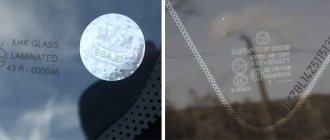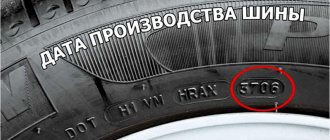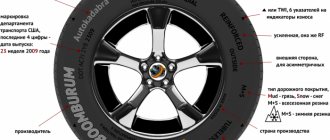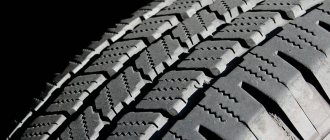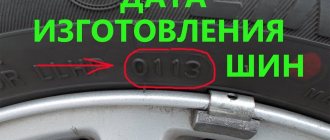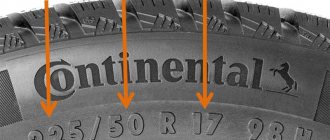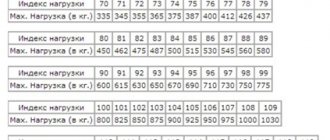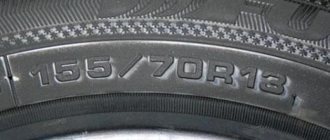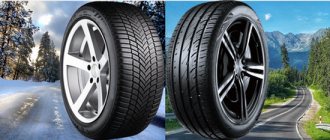A lot depends on the right choice of shoes for your car. When deciding to purchase a kit, you can be guided by various comparative tests. However, it is worth remembering that their characteristics must correspond to operating conditions. In this case, the information indicated in the markings on the sidewall of the tire will help. Such inscriptions on the tire indicate the size of the product and its technological characteristics. Below we will decipher the symbols and try to figure out what the numbers and letters in the rubber markings mean.
Tire size
The tire size indicates the physical parameters of the slope. This marking consists of three numbers and is located on the outside of the wheel. Example of these values: 175/70 R13, 185/60 R14, 195/50 R15, 195/65 R15C, 7.5/-R16 120L.
- The first number in the marking indicates the width of the tire in millimeters for passenger tires (175, 195, 185, etc.) or in inches for truck tires (6.45, 7.5, etc.).
- On passenger cars, it is customary to use the second number to indicate the ratio of the width of the tire to the height of its sidewall as a percentage. For example, in the marking 175/70 R13, the number 70 means that the height of the side part is equal to 70% of 175 mm, which means 175 * 70/100 = 122.5 mm.
- The letter “R” means radial wheel design (it is not used on bias-ply tires), “C” after the inner radius is placed on commercial vehicle tires, which are designed for increased loads. Additional letters are placed on tires for the American market: LT - “Light truck” slopes for light trucks or jeeps, P - “Passenger Car” for a passenger car, ST - “Special Trailer” for trailers, and T - “Temporary” for spare tires or document.
How to decipher tire markings?
The choice of car tires is always a crucial moment in the life of every motorist. But to independently select the right car tires, you need to know the design features and understand the main markings that are applied to each car tire.
The following combinations of designations of the main parameters are accepted on all car tires:
Manufacturer and model information
In addition to the size, the brand name and model are printed on the side to identify the tires, for example: Nokian Hakka Green, Michelin Energy, Toyo Proxes, Good year Ultra Grip, Belshina BEL-347, Amtel NordMaster, Hankook K415 Optimo and others.
The inscription “ Made in... ” indicates the country of manufacture (Russia (Russia), Germany (Germany), USA (USA), France (France), China (China), etc.).
The year and week of manufacture on the tires are marked in a rounded oval with four numbers: for example, “0915” would mean that the tire was made in the 9th week of 2015.
Please explain the difference between 175/65 and 185/60 tires. What do these numbers mean?
If it’s winter in the city, then you need to take the same width as summer ones - for a car weighing a ton, you shouldn’t take 185, if you don’t drive on asphalt, take the narrowest ones - it’s better on snow, but traction on asphalt is a nightmare...
175 is the profile width in millimeters, and 65 is the height in %% relative to the width.
175 and 185 are the width in millimeters and 65 and 60 are the height in percentages, which means the height is relatively the same and 185 is 1 cm wider.
There is no difference whether it is winter or summer, it is height and width. Depends on the car model. The size supplied at the factory is preferable.
175 width 65 height tires in winter, narrower tires are preferable
narrower is better for the winter. you can visually estimate here - tires.spb.ru/index.php?mid=11 the first one will be 3 mm higher, with a radius of 14 Discs are suitable for both options
touch.otvet.mail.ru
Indices of permissible load and speeds
Load index (LOI) - designation by numbers of the permissible load on a tire in kilograms. The value ranges from 0 (45 kg) to 279 (136,000 kg). You can find out in detail which index is in the table below:
| ANN | MAX, kg | ANN | MAX, kg | ANN | MAX, kg | ANN | MAX, kg | ANN | MAX, kg | ANN | MAX, kg | ANN | MAX, kg |
| 0 | 45 | 40 | 140 | 80 | 450 | 120 | 1400 | 160 | 4500 | 200 | 14000 | 240 | 45000 |
| 1 | 46,2 | 41 | 145 | 81 | 462 | 121 | 1450 | 161 | 4625 | 201 | 14500 | 241 | 46250 |
| 2 | 47,5 | 42 | 150 | 82 | 475 | 122 | 1500 | 162 | 4750 | 202 | 15000 | 242 | 47500 |
| 3 | 48,7 | 43 | 155 | 83 | 487 | 123 | 1550 | 163 | 4875 | 203 | 15500 | 243 | 48750 |
| 4 | 50 | 44 | 160 | 84 | 500 | 124 | 1600 | 164 | 5000 | 204 | 16000 | 244 | 50000 |
| 5 | 51,5 | 45 | 165 | 85 | 515 | 125 | 1650 | 165 | 5150 | 205 | 16500 | 245 | 51500 |
| 6 | 53 | 46 | 170 | 86 | 530 | 126 | 1700 | 166 | 5300 | 206 | 17000 | 246 | 53000 |
| 7 | 54,5 | 47 | 175 | 87 | 545 | 127 | 1750 | 167 | 5450 | 207 | 17500 | 247 | 54500 |
| 8 | 56 | 48 | 180 | 88 | 560 | 128 | 1800 | 168 | 5600 | 208 | 18000 | 248 | 56000 |
| 9 | 58 | 49 | 185 | 89 | 580 | 129 | 1850 | 169 | 5800 | 209 | 18500 | 249 | 58000 |
| 10 | 60 | 50 | 190 | 90 | 600 | 130 | 1900 | 170 | 6000 | 210 | 19000 | 250 | 60000 |
| 11 | 61,5 | 51 | 195 | 91 | 615 | 131 | 1950 | 171 | 6150 | 211 | 19500 | 251 | 61500 |
| 12 | 63 | 52 | 200 | 92 | 630 | 132 | 2000 | 172 | 6300 | 212 | 20000 | 252 | 63000 |
| 13 | 65 | 53 | 206 | 93 | 650 | 133 | 2060 | 173 | 6500 | 213 | 20600 | 253 | 65000 |
| 14 | 67 | 54 | 212 | 94 | 670 | 134 | 2120 | 174 | 6700 | 214 | 21200 | 254 | 67000 |
| 15 | 69 | 55 | 218 | 95 | 690 | 135 | 2180 | 175 | 6900 | 215 | 21800 | 255 | 69000 |
| 16 | 71 | 56 | 224 | 96 | 710 | 136 | 2240 | 176 | 7100 | 216 | 22400 | 256 | 71000 |
| 17 | 73 | 57 | 230 | 97 | 730 | 137 | 2300 | 177 | 7300 | 217 | 23000 | 257 | 73000 |
| 18 | 75 | 58 | 236 | 98 | 750 | 138 | 2360 | 178 | 7500 | 218 | 23600 | 258 | 75000 |
| 19 | 77,5 | 59 | 243 | 99 | 775 | 139 | 2430 | 179 | 7750 | 219 | 24300 | 259 | 77500 |
| 20 | 80 | 60 | 250 | 100 | 800 | 140 | 2500 | 180 | 8000 | 220 | 25000 | 260 | 80000 |
| 21 | 82,5 | 61 | 257 | 101 | 825 | 141 | 2575 | 181 | 8250 | 221 | 25750 | 261 | 82500 |
| 22 | 86 | 62 | 265 | 102 | 850 | 142 | 2650 | 182 | 8500 | 222 | 26500 | 262 | 85000 |
| 23 | 87,5 | 63 | 272 | 103 | 875 | 143 | 2725 | 183 | 8750 | 223 | 27250 | 263 | 87500 |
| 24 | 90 | 64 | 280 | 104 | 900 | 144 | 2800 | 184 | 9000 | 224 | 28000 | 264 | 90000 |
| 25 | 92,5 | 65 | 290 | 105 | 925 | 145 | 2900 | 185 | 9250 | 225 | 29000 | 265 | 92500 |
| 26 | 95 | 66 | 300 | 106 | 950 | 146 | 3000 | 186 | 9500 | 226 | 30000 | 266 | 97500 |
| 27 | 97,5 | 67 | 307 | 107 | 975 | 147 | 3075 | 187 | 9750 | 227 | 30750 | 267 | 97500 |
| 28 | 100 | 68 | 315 | 108 | 1000 | 148 | 3150 | 188 | 10000 | 228 | 31500 | 268 | 100000 |
| 29 | 103 | 69 | 325 | 109 | 1030 | 149 | 3250 | 189 | 10300 | 229 | 32500 | 269 | 103000 |
| 30 | 106 | 70 | 335 | 110 | 1060 | 150 | 3350 | 190 | 10600 | 230 | 33500 | 270 | 106000 |
| 31 | 109 | 71 | 345 | 111 | 1090 | 151 | 3450 | 191 | 10900 | 231 | 34500 | 271 | 109000 |
| 32 | 112 | 72 | 355 | 112 | 1120 | 152 | 3550 | 192 | 11200 | 232 | 35500 | 272 | 112000 |
| 33 | 115 | 73 | 365 | 113 | 1150 | 153 | 3650 | 193 | 11500 | 233 | 36500 | 273 | 115000 |
| 34 | 118 | 74 | 375 | 114 | 1180 | 154 | 3750 | 194 | 11800 | 234 | 37500 | 274 | 118000 |
| 35 | 121 | 75 | 387 | 115 | 1215 | 155 | 3875 | 195 | 12150 | 235 | 38750 | 275 | 121000 |
| 36 | 125 | 76 | 400 | 116 | 1250 | 156 | 4000 | 196 | 12500 | 236 | 40000 | 276 | 125000 |
| 37 | 128 | 77 | 412 | 117 | 1285 | 157 | 4125 | 197 | 12850 | 237 | 41250 | 277 | 128500 |
| 38 | 132 | 78 | 426 | 118 | 1320 | 158 | 4250 | 198 | 13200 | 238 | 42500 | 278 | 132000 |
| 39 | 136 | 79 | 437 | 119 | 1360 | 159 | 4375 | 199 | 13600 | 239 | 43750 | 279 | 136000 |
Tires intended for the North American market are also embossed with the “Maximum Pressure” , which is measured in pounds per square inch (1 PSI = 0.068046 Atmospheres) and “Maximum Load” , in pounds or kilograms. Max. press. means the maximum permissible pressure in cold tires, and Max. load - load.
The speed index is an indicator of the maximum permissible speed to which tires can accelerate. The value is indicated in Latin letters from A to Z and, accordingly, the speed limit is 5-300 km/h (there is no marking above 300 km/h).
| Index | M/h | km/h | Index | M/h | km/h |
| A1 | 3 | 5 | L | 75 | 120 |
| A2 | 6 | 10 | M | 81 | 130 |
| A3 | 9 | 15 | N | 87 | 140 |
| A4 | 12 | 20 | P | 94 | 150 |
| A5 | 16 | 25 | Q | 100 | 160 |
| A6 | 19 | 30 | R | 106 | 170 |
| A7 | 22 | 35 | S | 112 | 180 |
| A8 | 25 | 40 | T | 118 | 190 |
| B | 31 | 50 | U | 124 | 200 |
| C | 37 | 60 | H | 130 | 210 |
| D | 40 | 65 | V | 149 | 240 |
| E | 43 | 70 | Z/ZR | over 149 | over 240 |
| F | 50 | 80 | W | 168 | 270 |
| G | 56 | 90 | (W) | over 168 | over 270 |
| J | 62 | 100 | Y | 186 | 300 |
| K | 68 | 110 | (Y) | over 186 | over 300 |
Read more about tire indexes at the link.
P 185/65 R14 86 N
- P – designation of the type of vehicle for which these tires are intended. “P or Passanger” - passenger car, “LT or Light Truck” - light truck, etc.
P 185/65 R14 86 N
- 185 – value of the tire profile width, mm.
- 65 – the value of the tire profile height, measured as a percentage of the width. If a standard size without height is specified, for example 175 R13, the height is assumed to be 80-82% (full-profile tires).
- R – tire design, divided into radial (R) and diagonal (D). The radial design is characterized by a parallel arrangement of rubberized cord threads, the diagonal design is characterized by an overlapping arrangement of threads.
- 14 – distance between the inner edges of the tire i.e. its internal diameter is calculated in inches.
- 86 – coefficient or load index. Indicates the permissible load per tire in kg.
| Load Index | 60 | 61 | 62 | 63 | 64 | 65 | 66 | 67 | 68 | 69 |
| Max. Load (in kg.) | 250 | 257 | 265 | 272 | 280 | 290 | 300 | 307 | 315 | 325 |
| Load Index | 70 | 71 | 72 | 73 | 74 | 75 | 76 | 77 | 78 | 79 |
| Max. Load (in kg.) | 335 | 345 | 355 | 365 | 375 | 387 | 400 | 412 | 426 | 437 |
| Load Index | 80 | 81 | 82 | 83 | 84 | 85 | 86 | 87 | 88 | 89 |
| Max. Load (in kg.) | 450 | 462 | 475 | 487 | 500 | 515 | 530 | 545 | 560 | 580 |
| Load Index | 90 | 91 | 92 | 93 | 94 | 95 | 96 | 97 | 98 | 99 |
| Max. Load (in kg.) | 600 | 615 | 630 | 650 | 670 | 690 | 710 | 730 | 750 | 775 |
| Load Index | 100 | 101 | 102 | 103 | 104 | 105 | 106 | 107 | 108 | 109 |
| Max. Load (in kg.) | 800 | 825 | 850 | 875 | 900 | 925 | 950 | 975 | 1000 | 1030 |
| Load Index | 110 | 111 | 112 | 113 | 114 | 115 | 116 | 117 | 118 | 119 |
| Max. Load (in kg.) | 1060 | 1090 | 1120 | 1150 | 1180 | 1215 | 1250 | 1285 | 1320 | 1360 |
| Load Index | 120 | 121 | 122 | 123 | 124 | 125 | 126 | 127 | 128 | 129 |
| Max. Load (in kg.) | 1400 | 1450 | 1500 | 1550 | 1600 | 1650 | 1700 | 1750 | 1800 | 1850 |
- H – speed coefficient or index. Indicates the value of the maximum permissible speed at which safe movement is possible.
| Speed index | J | K | L | M | N | P | Q | R | S | T | U | H | V | VR | W | Y | ZR |
| Max. Speed (km/h) | 100 | 110 | 120 | 130 | 140 | 150 | 160 | 170 | 180 | 190 | 200 | 210 | 240 | >210 | 270 | 300 | >240 |
Tire design
All design features of wheels are often also marked on the sidewall.
Radial or bias tires
As mentioned earlier, radial tires are marked with the letter “R” in the main size index or the inscription “Radial”, and for diagonal tires this letter is simply absent. The difference between these tires is the arrangement of the cords, which increase the torsional rigidity and loads on the tire. In bias-ply tires, the steel threads are intertwined at right angles, while in radial tires, the threads are evenly spaced from the edge of one bead to the other.
Which tire design is better ? Radial tires have greater wear resistance than bias-ply tires - they can travel over 60,000 km, while their competitor can barely cope with half that mileage. In addition, the stability and controllability of diagonal tires is worse, as is rolling resistance, which affects increased fuel consumption. The design of the radial tire also includes a breaker, which increases the rigidity of the sidewall. Such slopes help to achieve a more stable and larger contact patch with the road. Almost all modern tires are radial.
Tube and tubeless tires
Tires marked “Tubeless” or TL are called tubeless. In these tires, air is directly pumped through the nipple.
Tube tires are labeled “Tube Type” or TT. In such slopes, air is pumped into a rubber chamber, which is installed inside the tire.
Tubeless tires have a number of advantages over their outdated counterparts:
- Less weight due to the absence of a camera and simplified design.
- When punctured, tubeless tires deflate much more slowly.
- They overheat less and, as a result, break down more slowly.
Other design features
- Regroovable - installed on tires that can be used to deepen the tread by cutting.
- Reinforced - tires with an increased load index.
- XL or Extra load - marking of tires with a load index increased by 4 units.
- Steel or Steel belted - the designation is applied to slopes with a steel cord in the breaker (tire sidewall).
- For asymmetrical and directional tires, the designation Outside / Inside to show which side the wheel should be placed on the car (the text Inside should be on the inside, and Outside on the outside. In addition, if the tread pattern is directional, there is the word Rotation and an arrow indicating the direction of rotation wheels.
- Runflat is the latest development of the tire giants; the presence of such markings indicates the possibility of driving on a punctured tire. Different brands mark it with symbols: RFT (Bridgestone), SSR (Continental), EMT (Goodyear), ZP (Michelin), RF (Pirelli, Nokian, Kumho, Yokohama), EUFORI@ (Pirelli).
- Retread, Remould or Regummerad inscriptions are applied to retreaded tires, that is, those whose tread has been re-welded. This is usually done with truck tires, but it is not uncommon for passenger cars.
Options
When selecting wheels for a car, you need to remember that a wheel consists of rubber and a disk. The dimensions must be observed very strictly, because... Not only the suspension and smoothness of movement, but also the handling of the car depends on this.
There are several basic parameters when selecting - you need to pay primary attention to them. To choose tires - these are:
- Tire width;
- Height;
- Cross-sectional height;
- Wheel inner diameter;
- Outer radius of the tire.
Based on this data, you can find out all the basic information about the tire.
Main tire sizes
An example of deciphering the tire size 175/65R14 82H (suitable for Lada Priora): width is 175 mm, height is 65% of the width, the wheel rim suitable for the specified tires must be 14 in diameter, and the letter R indicates that the tire is of radial design. For this tire, the load index is 82, and the speed class is H. But the latter indicators are selected less frequently, because manufacturers produce tires with high performance, and almost any tire will meet the necessary characteristics under normal operating conditions.
An example of tire size decoding
Important: each make and model of car has its own size of tires and wheels, and installing a different size without consulting a specialist can lead to loss of vehicle performance and other negative consequences.
Discs
Choosing tires is half the battle. For each tire you need to select a wheel - the choice is surprising in its vastness, but choosing the wheel you like does not mean that it will fit the selected tire. It is necessary to know exactly the appropriate parameters, and when choosing disks, pay attention to the markings (or consult with a specialist), which should be freely available to the client.
Disc markings
Markings of this type are designated as follows (for example, R14 6 * 14 ET35 DIA 58.6 for Lada Priora is used):
- R14 – disc diameter (must match the inner radius of the rubber).
- 6*14 – number of bolts for fastening, and size of mounting holes.
- ET35 – departure.
- DIA6 – radius of the hole for the machine hub.
In addition, you need to pay serious attention to the width of the rim - indicated in inches (1 inch - 2.54 cm). This parameter is calculated by simply dividing the tire width by the required value (before calculations, you need to convert all values into centimeters), the resulting value will be in inches, after that, the figure is rounded, and a disk is selected for this value.
Rim width is an important parameter
There are cases when the selected instances are suitable in all respects, but installation is still impossible. This is due to the characteristics of the car, suspension, and other factors affecting the wheel. To eliminate such an accident, you need to “try on” the disc before purchasing.
Attention: the matching of tires and wheels must be absolute so that all components of the set fit perfectly together.
The corresponding rims can be taken from the tire size table:
| Tire width | Height | Disc Width (inch) | ||
| Minimum | Recommended | Maximum | ||
| R13 | ||||
| 145 155 165 175 | 82 | 3.5 4.0 4.0 4.5 | 4.0 4.5 4.5 5.0 | 5.0 5.5 5.5 6.0 |
| 135 145 155 165 | 80 | 3.5 3.5 4.0 4.0 | 3.5 4.0 4.5 4.5 | 4.5 5.0 5.5 5.5 |
| 135 145 155 165 175 185 195 | 70 | 3.5 4.0 4.0 4.5 5.0 5.0 5.2 | 4.0 4.5 4.5 5.0 5.0 5.5 6.0 | 4.5 5.0 5.5 6.0 6.0 6.5 7.0 |
| 155 165 175 | 65 | 4.0 4.5 5.0 | 4.5 5.0 5.0 | 5.5 6.0 6.0 |
| 175 185 205 | 60 | 5.0 5.5 5.5 | 5.0 5.5 6.0 | 6.0 6 .5 7.0 |
| 195 | 55 | 5.5 | 6.0 | 7.0 |
| R14 | ||||
| 165 175 185 195 205 | 70 | 4.5 5.0 5.0 5.5 5.5 | 5.0 5.0 5.5 6.0 6.0 | 6.0 6.0 6.5 7.0 7.5 |
| 155 165 175 185 195 | 65 | 4.0 4.5 5.0 5.0 5.5 | 4.5 5.0 5.0 5.5 6.0 | 5.5 6.0 6.0 6.5 7.0 |
| 165 175 185 195 205 | 60 | 4.5 5.0 5.0 5.5 5.5 | 5.0 5.0 5.5 6.0 6.0 | 6.0 6.0 6.5 7.0 7.5 |
| R15 | ||||
| 175 195 235 | 70 | 5.0 5.5 6.5 | 5.0 6.0 7.0 | 6.0 7.0 8.5 |
| 185 195 205 215 225 | 65 | 5.0 5.5 5.5 6.0 6.0 | 5.5 6.0 6.0 6.5 6.5 | 6.5 7.0 7.5 7.5 8.0 |
| 195 205 215 225 | 60 | 5.5 5.5 6.0 6.0 | 6.0 6.0 6.5 6.5 | 7.0 7.5 8.0 8.0 |
| 185 195 205 225 | 55 | 5.0 5.5 5.5 6.0 | 6.0 6.0 6.5 7.0 | 6.5 7.0 7.5 8.0 |
| R16 | ||||
| 215 | 65 | 5.5 | 6.5 | 7.5 |
| 225 235 | 60 | 6.0 6.5 | 6.5 7.0 | 8.0 8.5 |
| 205 225 245 | 55 | 5.5 6.0 7.0 | 6.5 7.0 7.5 | 7.5 8.0 8.5 |
| 205 225 235 255 | 50 | 5.5 6.0 6.5 7.0 | 6.5 7.0 7.5 8.0 | 7.5 8.0 8.5 9.0 |
| 195 205 225 245 | 45 | 6.0 6.5 7.0 7.5 | 6.5 7.0 7.5 8.0 | 7.5 7.5 8.5 9.0 |
| 215 225 | 40 | 7.0 7.5 | 7.5 8.0 | 8.5 9.0 |
The table shows the minimum and maximum values for the most popular tire sizes for Lada, Nissan, Kia, Hyundai, Chevrolet Niva, and other common cars.
The list is given only from 13 to 16 radius - for other diameters, you must read the vehicle's operating instructions so as not to experience problems when selecting wheels and tires.
Seasonality and type of coverage
- All Seasons, As are placed on the outside of all-season ones, that is, those that can be used in both winter and summer.
- R+W (Road+winter) marking of slopes intended for regular roads and winter conditions, another subtype of all-season ones
- Any Weather, Aw tires designed for any weather.
- M+S, M&S or MS stands for “Mud and Snow”, tires designed for winter weather and melted snow in particular.
- Snowflake - an icon against a background of three mountain peaks is applied to the sidewall of winter tires. This marking can be installed by manufacturers whose slopes have passed the road grip test 10% better compared to the Uniroyal Tiger standard.
- The umbrella pictogram or the inscriptions Aquatred, Aquacontact are applied to tires intended for rain.
Additional markings on tires
- Extra Load (XL) - increased load index (many manufacturers abuse this marking for the sake of marketing).
- Left or Right - means that the tires of this model are left and right. When installing them, you must strictly follow the rule for installing the tire on the car: left ones only on the left, and right ones, accordingly, only on the right.
- Max Load - maximum load and then the values are in kilograms and pounds.
- MAX PRESSURE - maximum permissible tire pressure, in kPa.
- MFS (Dunlop Maximum Flange Shield) - a maximum bead rim protection system developed by Dunlop, protects wheels from damage to curbs and sidewalks - a rubber profile around the circumference of the tire, located on the lower part of the wall above the rim flange, forms a buffer zone.
- Outside and Inside are asymmetrical tires, when installing which you must strictly follow the rule of installing the tire on the rim. The inscription Outside (outside) should be on the outside of the car, and Inside (inside) on the inside.
- PR (Ply Rating) - the strength of the frame is conditionally assessed by the so-called ply rate. The stronger the carcass, the more air pressure the tire can withstand and, therefore, have a greater load capacity. For passenger cars, tires with a frame load-bearing capacity of 4PR and sometimes 6PR are used, and in this case the latter are labeled “Reinforced”, that is, “reinforced” (increased load capacity).
- Reinforced (Reinf or RF) - increased load index. On light trucks and minibuses, the most common tires are 6PR and 8PR. The increased strength of the tire can be indicated by the letter “C” (commercial), which is placed after the designation of the bore diameter (for example, 185R14C).
- Rotation - Tires with a directional tread pattern have an arrow on the sidewall of the tire indicating the desired direction of rotation of the tire.
- Steel Radial - radial tire with metal cord (metal cord tires).
- SST - Self Supporting Tires. These tires can carry the load and continue driving after a puncture.
- Studless - the tire cannot be studded.
- Studdable - the tire can be studded.
- Traction A - coefficient of adhesion, has values A, B, C. Coefficient A has the largest amount of adhesion in its class.
- Tube Type (TT) - the tire must be used with a tube.
- TWI - the sign is located on the sidewall of the tire and shows the location of the remaining tread height marks in the main grooves. For the countries of the European Union and the Russian Federation, the remaining tread height of a worn passenger tire must be at least 1.6 mm.
- ZP - zero pressure (Zéro Pression), Michelin's commercial designation for tires with reinforced sidewalls. ZP - the ability to continue driving in the event of a puncture for a distance of up to 80 km at a speed of up to 80 km/h. ZP SR - the ability to continue driving in the event of a puncture for a distance of up to 30 km at speeds of up to 80 km/h.
There is also environmental labeling, which is provided in Europe and Southeast Asia (for example, in Japan and Korea). It characterizes tires in terms of fuel efficiency and noise level.
Please note that the presence of the letter C after the diameter in the code on the sidewall of the tire, for example, 195/65R15C 104/102R, means “commercial”, that is, this tire is intended for pickups or small heavy-duty trucks. After the size there may be letter codes XL, RF, SL, LL (for example, P235/75R-15 XL, P285/35R-19 LL). They mean, respectively, increased (extra load, reinforced), standard (standard load), and reduced (light load) load-bearing capacity of the tire carcass. In the American P-marking, the XL code corresponds to a maximum permissible pressure of 41 psi (280 kPa), SL and LL - 35 psi (240 kPa), in the European marking XL/RF corresponds to 42 psi (290 kPa), SL - 36 psi (250 kPa ). The letters FR (for example, 225/50 R18 87V FR) after the size indicate a tire with rim protection. You can distinguish an American tire from a European one by the quality standard code: the letter “E” in a circle means a European standard, and the abbreviation “DOT” means an American tire.
Is it possible to find out the year of manufacture of a tire by marking? Yes, such information is encrypted in a four-digit number inside an oval on the side surface of the tire. In the infographic above, this code can be seen at the bottom left of the wheel diagram. The first two digits of this code contain the serial number of the week in the year, and the last two digits are the year of manufacture of the tire. For example, if your tire has the number 1119 in this block, this will mean that the tire was released in 2022, in the 11th week, that is, in March.
Previous post Fraudsters are selling fake MTPL policies, the numbers of which are entered through the RSA
Next entry Rules for passing the traffic police exam for a license
Wear
Many manufacturers took care of the end consumer and installed a wear indicator on their tires. Its presence on the tire is indicated by Tread Wear Indication or TWI . Each brand has its own way of showing the tread depth, for example:
- Michelin installs a triangle on the top of the sidewall that shows exactly where the wear indicator is located.
- Nokian, Matador and many other companies cut out numbers on the tread that indicate the tread depth in millimeters; gradually, as the tire wears out, the layer wears off from one number to another.
- Other brands place a perpendicular partition in the tread grooves, the height of which will indicate that the tire is completely worn out
The minimum permissible wear for passenger vehicles is 1.6 mm, which applies both in Russia and in all European countries. It is believed that this is the last frontier that at least somehow prevents the tire from hydroplaning in puddles.
The tread depth of new summer slopes is usually 7-8 mm, winter ones 8-10 depending on the type of pattern.
Deciphering permanent inscriptions
As a rule, there are several standard designations on a tire that are common to all companies.
Brand, model, logo
On each tire, the manufacturer indicates the name of the company, brand of tire, as well as some other inscriptions.
Tire sizes
In all cases, the tire contains numbers indicating the tire size. They may differ on European and American products. You have already read above about how to decipher these inscriptions. The most interesting thing is that if you get used to the inch measurement system, the American method is more understandable. After all, with the same profile height, different tires may have different actual performance due to the width of the rubber.
Speed index
Each tire has a mandatory letter marking, indicating what maximum speed can be achieved on these tires. The closer the letter is to the end of the alphabet, the higher this indicator. If the letter S or T is indicated on the sidewall, then on such a tire you can reach a speed of 180 or 190 km/h. The symbols U, H or V indicate a maximum of 200, 210 and 240 km/h respectively. There are super-fast Potenza models that can withstand the load at speeds of 270-300 km/h. Such tires have a W or Y value.
Load Index
On all brands of tires, next to the speed indicator there is a number indicating the maximum load index. The higher this indicator, the more weight the wheel carries.
Information table
| Index | Load, kg |
| 60-70 | 250-335 |
| 71-80 | 345-450 |
| 81-90 | 462-600 |
| 91-100 | 615-800 |
| 101-110 | 825-1060 |
| 111-120 | 1090-1400 |
| 121-130 | 1450-1850 |
If the wheel is marked EL (Extra Load), then the load index becomes three units higher. This indicates a reinforced sidewall and wheel cord. These tires are used by light trucks or as a spare tire for heavy vehicles.
It is worth adding that this indicator is calculated at the maximum permissible pressure. Otherwise, if there is a significant load, the rubber may become deformed and fly off the rim of the disc. Therefore, under heavy loads, you should carefully monitor the tire pressure. You can find out what pressure your tires should be by looking at the Max Pressure index printed near the inner cord.
Compliance
Tires produced in the CIS countries and Russia in particular have inscriptions indicating that they comply with state standards or certain technical conditions. On the sidewall they are applied with the document code, for example: GOST 4754-97 or TU2521-036-00148984-98. In addition, tires certified in Russia are sometimes marked with the PCT mark, which indicates the presence of a certificate.
Tires intended for the European market are embossed with a sign of compliance with UNECE rules N30. The number in the circle is the country code, and the one outside is the designation of the standard, for example E4 0220984.
Tires produced for the North American market are marked DOT (Department of Transportation USA), which consists of an alphanumeric code that encrypts the manufacturer, the size of the slope, and the manufacturing plant, for example, DOT M746 JR1R.
What is 92H?
Example: 205/60 R16 92H
, where 92 is the permissible load index on one wheel, and H is the permissible speed index. ...
Interesting materials:
How to transfer an application that is not in the appstore? How to transfer applications from internal memory to a flash drive? How to transfer applications to Samsung SD card? How to transfer system applications to a memory card? How to transfer downloaded applications to a memory card? How to drag applications to a memory card? How to reinstall the Mego app on TV? How to restart the bank's opening mobile application? How to clear the cache in an application? How to share an application on WhatsApp?
Color markings
In addition, each manufacturer, for its own convenience or specific needs, can apply different marks of its own for each tire.
- Yellow marks are placed on the lightest part of the tire as a place to install the nipple, simplifying the work of the tire fitter.
- The red mark on the tire indicates the place of greatest heterogeneity or the heaviest part.
- Colored stripes on the tread in a variety of colors are designed to simplify logistics and help distribute tires to warehouses.
- A white circle with a number on the side is a sign corresponding to the Soviet Quality Control Department (technical control department), which means inspection at the warehouse by the supplier.
Tire sticker
One of the new trends in tire labeling is stickers that are placed on the tread before sale. On them you can find out the rolling resistance, noise and braking of the car on wet asphalt.
- Rolling resistance or RRC (Rolling Resistance Coeficient) is measured in the letters A, B, C, D, E, F, G. A is considered the best, which means the lowest coefficient. The remaining letters increase fuel consumption on the reference car with a consumption of 6.6 l / 100 km.
- Braking on wet asphalt, as in the previous example, is measured in the letters of the Latin alphabet: A, B, C, D, E, F, G, where the letter A will mean the shortest braking distance on wet asphalt.
- The noise level of a tire is indicated by a speaker icon with a tire and a dB level marked. If all sound waves are filled with black, then the slope has 75 or more dB, which will be prohibited in the EU from 2016.
If you have read this article to the end, congratulations, you can confidently consider yourself an expert in tire markings.
Tire markings decoding was last modified: April 25th, 2017 by abc-tyre
Decoding tire markings: all the subtleties
When you decide to buy new tires for your car, when choosing in a store, you will certainly be faced with the fact that there will be a lot of letters and numbers on them that are difficult for an inexperienced person to understand. Which ones are the most important and what do they mean? Let's understand the decoding of the notation.
- 2 Designation of sizes and their interpretation
- 3 Load capacity index
- 4 Speed + table by meaning of letters
- 5 Wear resistance
- 6 Temperature quality index
- 7 Grip qualities
- 8 Maximum pressure parameter
- 9 Purpose, seasonality
- 10 Date of manufacture
- 11 Designation of tube/tubeless tires
- 12 Car tire certification index
- 13 Rotation direction sign or outside tire sign
- 14 Additional indexes
